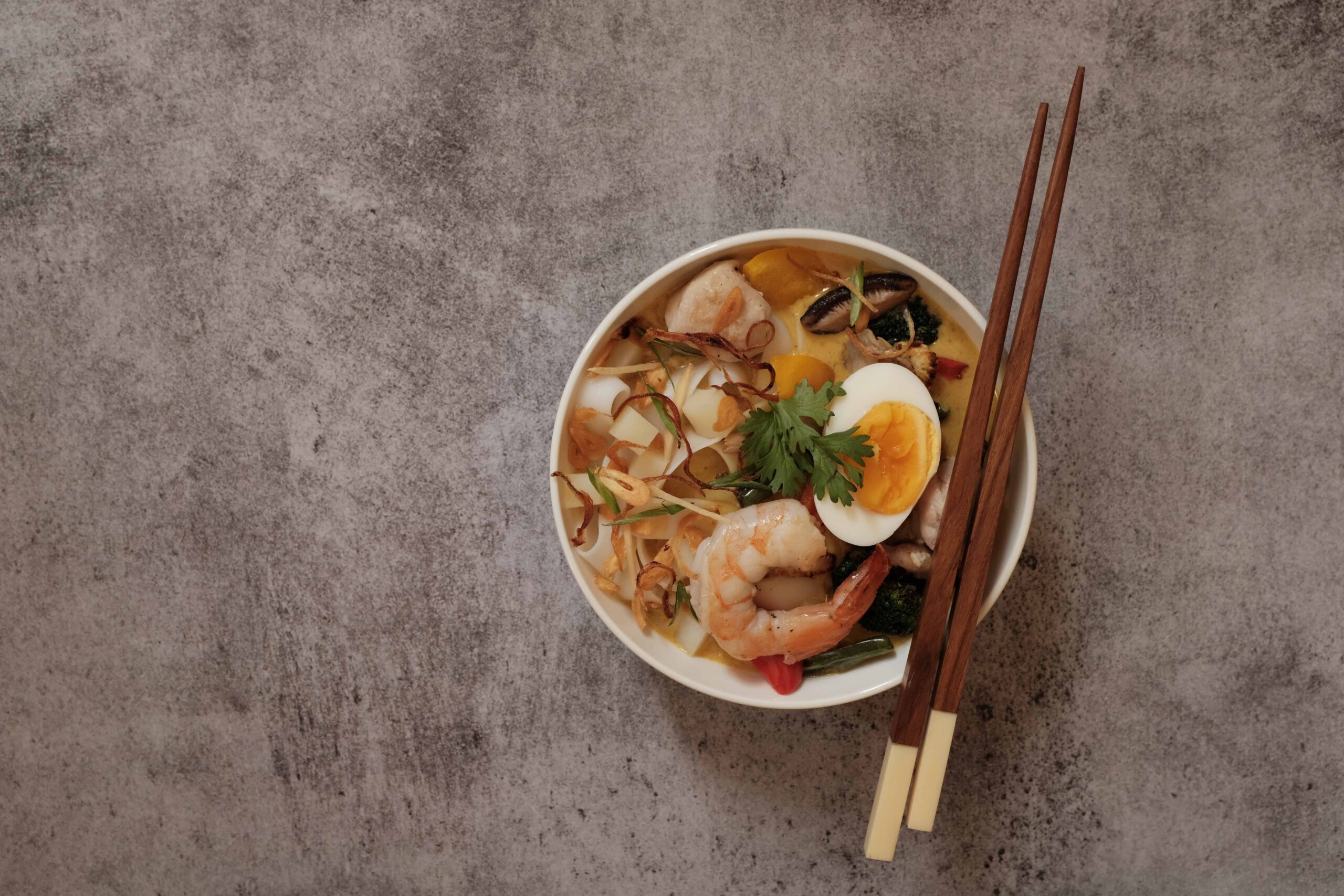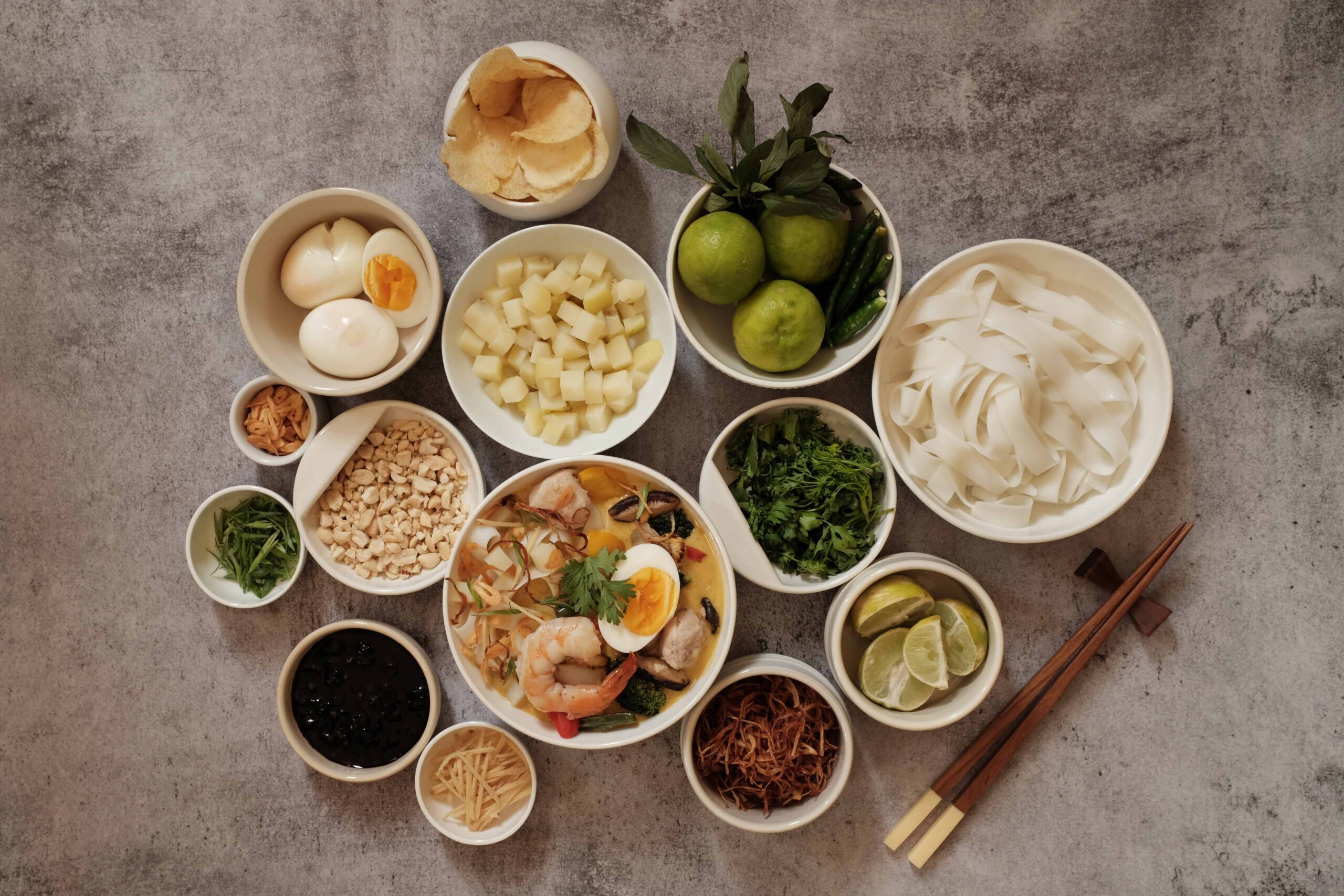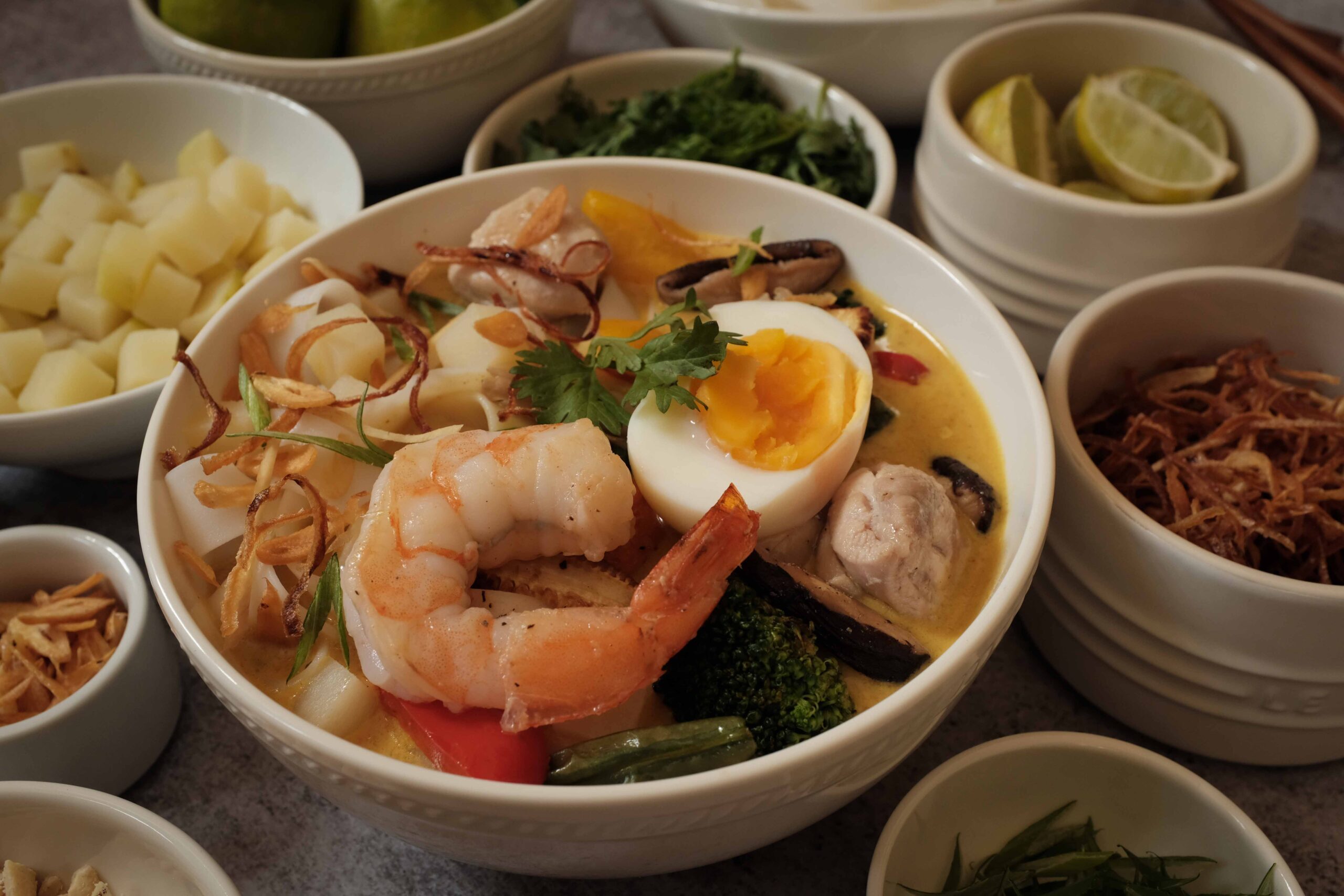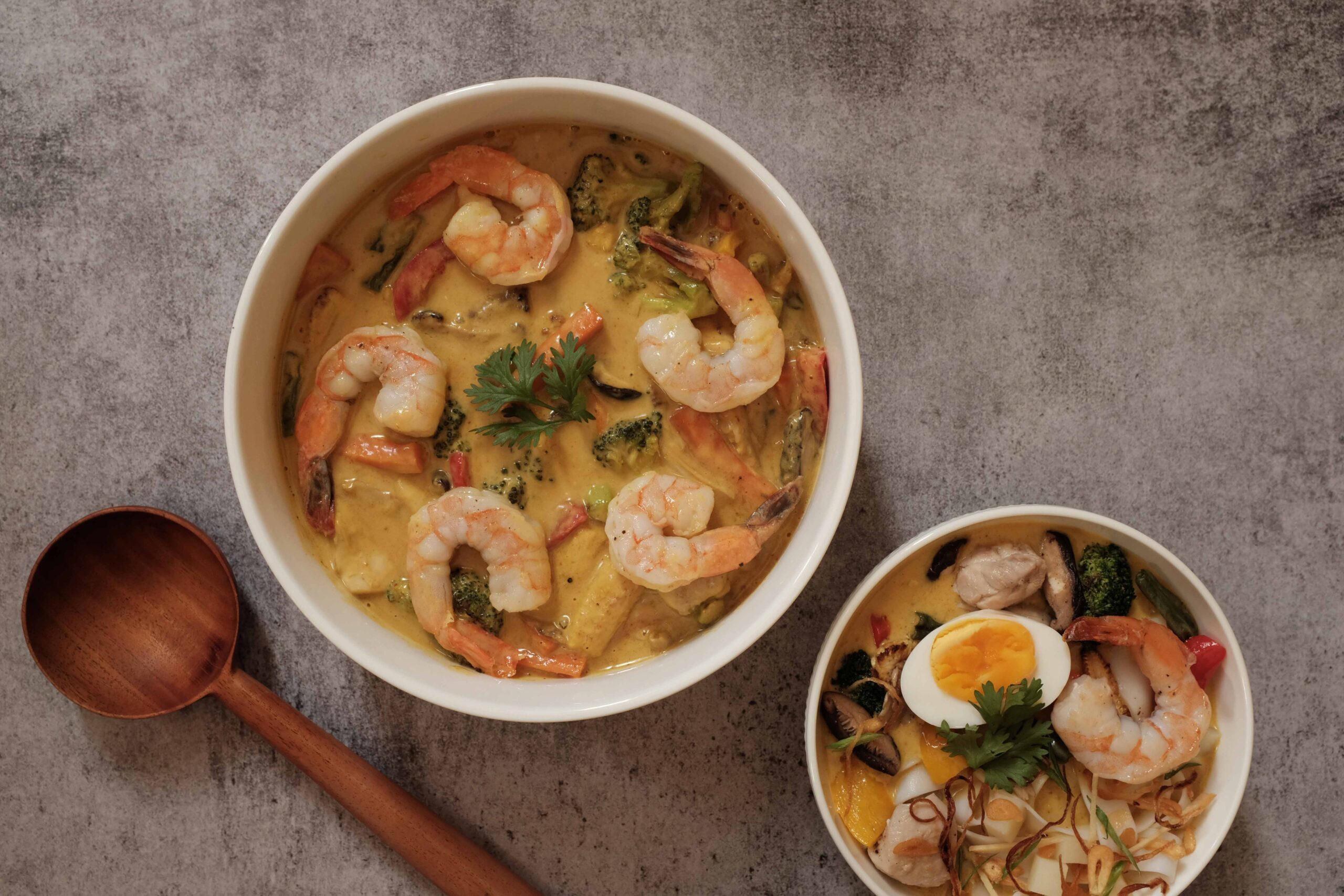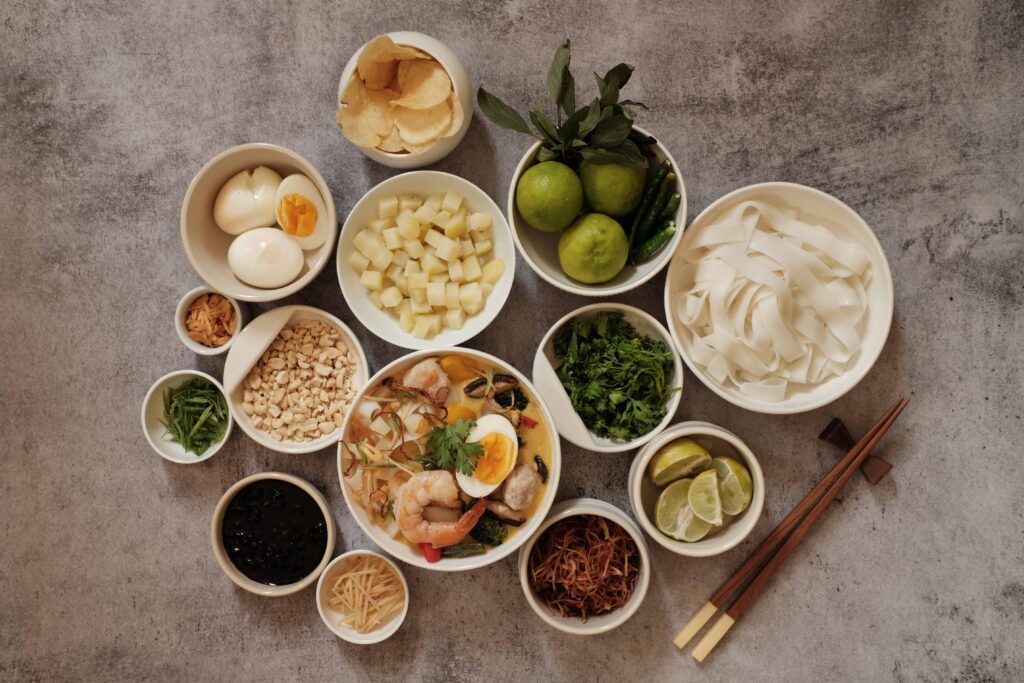Makes 4-6 servings.
Khow Suey or ohn no khao swè is a curry based noodle soup that is topped with a variety of condiments. Brought to the subcontinent during WWII by migrants from Myanmar (then Burma), no one Khow Suey is alike. Some are distinctly Indian, some reflect Pakistani influences, others stay true to their Burmese origins. Mine blends Indian spices with Thai aromatics—in a Burmese Khau Suey that pays homage to both its north-western and south-eastern neighbours, and their respective food influences.
At a glance
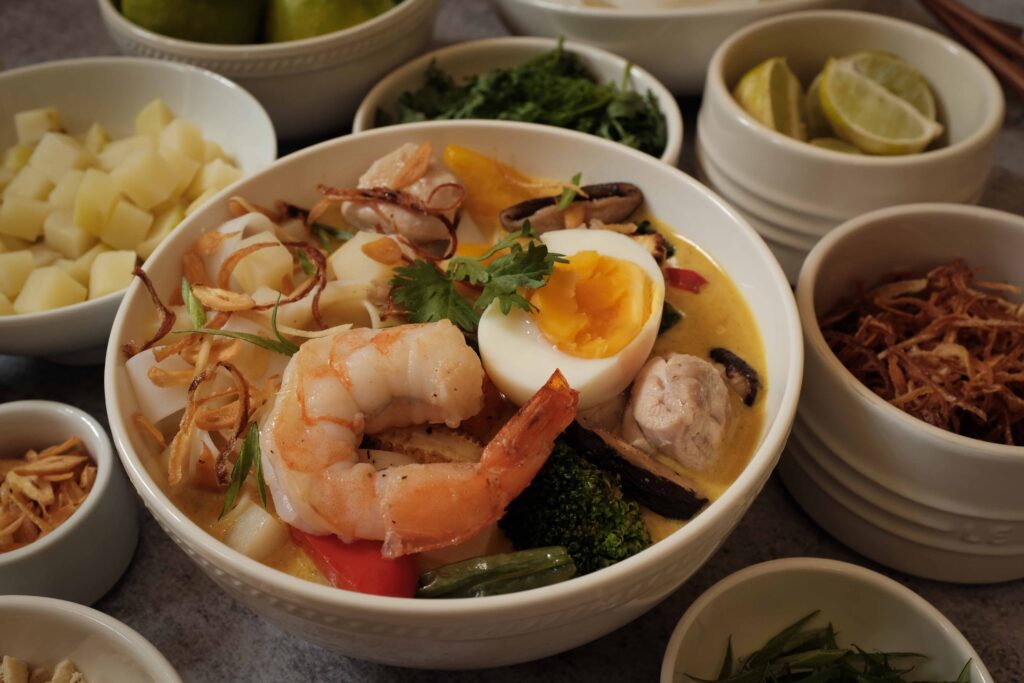
– This dish comprises toppings + curry + noodles
– You will need a large wok (4-5 litre capacity), a 3 litre pasta pot, and a deep frying pan.
– This recipe has been broken into 4 stages for ease and comprehension. Please read the entire recipe from start to finish before beginning.
Stage 1: toppings
The toppings play a crucial role in how the final Khow Suey eats. They add texture, complexity, and so much flavour. Because they take a little time to prepare, I like to tackle them first and get them out of the way. Toppings can be made in advance and stored in the fridge, or left on the countertop if they’re being used the same day.
Ingredients
Boiled toppings:
1. 2 medium potatoes (250 gm before peeling)
2. 3 eggs
Fried toppings:
3. 1 ltr neutral oil for deep frying
4. 2 medium red onions
5. 8 fat pods of garlic
6. 6 fresh green chillies
7. 60 ml soy sauce
Raw toppings:
8. ½ inch fresh ginger
9. 1 medium bunch coriander leaves (to give 1 ½ cups chopped coriander)
10. 1 small bunch fresh Thai basil leaves (24-30 leaves)
11. 1 spring onion stalk (green part only)
12. 2-3 green limes
13. 60 gm salted peanuts, skinless and roasted
14. 200 gm plain salted potato chips
Method
1 – Boiled potato topping; Boil the potatoes whole (roughly 15-20 minutes with a lid on). Once they’re cool, first peel, and then cut them into 1 cm cubes and place them in a bowl. Boiled potato is ready. Set aside.
2 – Boiled egg topping; Boil your eggs (6 ½ minutes). See this to make perfectly soft boiled eggs. Once they’re cool enough to handle, peel them and keep them in a bowl. Eggs are ready. Set aside and cut them into halves, only right before serving.
3 – Browned onions topping; Peel your onions. Cut them in half lengthwise, and then cut each half into fine slices (2 mm wide). Spread the onion slices on some kitchen paper for an hour to get rid of excess moisture. Heat up the oil in a deep frying pan. When the oil reaches 180OC, add the sliced onions in small batches, and deep fry them for 5-6 minutes. Then lower the heat and fry them until they’re golden brown. When they’re done, they will stop ‘fizzing’ and sort of float up to the surface of the oil. Immediately remove the golden brown onions from the pan and set them to drain on kitchen paper for 5 minutes. They will continue to cook after they’re out of the oil. Lightly salt each freshly fried batch. Then transfer to an airtight container. Onions are ready, set aside. Grab the same frying pan that you used to toast the spices. Heat up the vegetable oil in it. The depth of the oil should be at least 2 inches.
4 – Garlic chips topping; Peel and cut your garlic into thin slices (1 mm wide). Now add the garlic slices to the oil and fry them on low heat until they’re golden. Keep in mind that they will continue to brown off the heat, so remove them from the pan just before they begin to brown. Drain them on kitchen paper for 5 minutes and then store in an airtight container. Garlic chips are ready, set aside.
5 – Soy chillies toppping; Cut your green chillies into small rings. Fry them in the same hot oil for 2 minutes on low heat. Remove them from the pan and add them directly to a bowl containing 60 ml soy sauce. Chilli soy sauce is ready, set aside.
6 – Fresh ginger topping; Peel and cut your ginger into thin slices. Then julienne the slices. Place in a bowl, covered. Ginger is ready, set aside.
7 – Spring onion topping; Slice your spring onion stalk into thin diagonal rings. Place in a bowl, covered. Spring onion is ready, set aside.
8 – Fresh coriander topping; Roughly chop your fresh coriander leaves. Place in a bowl, covered. Fresh coriander is ready, set aside.
9 – Crushed peanuts topping; Crush your peanuts into coarse chunks. Place in an airtight container. Crushed peanuts are ready, set aside.
10 – Cut your limes into wedges. Place them in a bowl. Lime is ready, set aside.
11 – Store your salted chips in an airtight container. Potato chips are ready, set aside. Move on to Stage 2.
Stage 2: curry
Ingredients
For the veg and meat:
1. 100 gm carrot (roughly 1 small) cut into 3 x 1 cm batons
2. 70 gm French beans (roughly 10-12) cut into 3 cm long batons
3. 100 gm baby corn (roughly 5-6) halved lengthwise, then cut into 3 cm long batons
4. 150 gm broccoli cut into 3 cm florets
5. ½ of a small red capsicum, cut into 3 x 1 cm long batons
6. ½ of a small yellow capsicum cut into 3 x 1 cm long batons
7. 75 gm (roughly 7) shitake/button mushrooms cut lengthwise into 4 slices each
8. 75 gm oyster mushrooms torn into 4 cm florets
9. 400 gm boneless chicken thigh pieces cut into bit sized chunks (roughly 24)
10. 250 gm large prawns, deveined, tail-on (roughly 11-12 prawns)
11. Salt to taste
12. Freshly ground black pepper to taste
13. 3-4 tbsp. vegetable oil
For the aromatic paste:
14. 5 shallots
15. 1 inch piece fresh ginger
16. ½ inch piece fresh galangal
17. 4 fat garlic pods
18. 1 tsp Kashmiri red chilli powder
19. 1 tsp cumin powder
20. 1 tsp coriander powder
21. 1 tsp turmeric powder
22. 2 tender lemon grass stalks (bottom 7-8 cm sections only)
23. ¼ cup fresh coriander stems
24. 2 tsp freshly grated lime zest (from 6 large green limes)
25. 1 tbsp. vegetable oil
For the sauce:
26. 2 x 400 ml full fat Thai coconut milk (canned, non-homogenised)
27. 12 Thai basil leaves
28. 8 curry leaves
29. 3 tbsp. gram flour (besan)
30. 700 ml chicken broth, warmed (2 stock cubes dissolved in 700 ml hot water)
31. 1 whole lemon grass stalk bruised
32. 6 kaffir lime leaves bruised
33. ½ inch galangal piece, bruised
34. 1/8th cup freshly squeezed lime juice (use your zested limes for this)
35. 1 ½ tbsp. sugar or to taste
36. 2 ½ tbsp. fish sauce or to taste
Prep
1 – Keep all your veg cut and ready according to the sizes mentioned.
2 – Clean your chicken, pat it dry, and then cut it into bite-sized chunks. Clean and devein your prawns, leaving the tails on. Pat them dry. You don’t want any excess moisture whatsoever.
3 – Add all the aromatic paste ingredients to a blender jar. Grind the contents until you get a smooth paste. Set aside.
4 – Open both cans of coconut milk and scoop out 200 ml coconut cream from each can (it’s the white, creamy portion that is floating on the surface of your coconut milk). You should be left with one bowl containing 400 ml coconut cream and two cans containing 200 ml coconut milk, each. Set aside.
Method
1 – In a large wok, add 1 tablespoon of oil until shimmering. Then lower the flame to medium.
2 – Toss in the carrots and fry on medium heat until lightly caramelised, roughly 2 minutes. Sprinkle in salt and pepper and mix. Remove from the wok and set aside.
3 – Toss in the beans and fry on medium heat until lightly caramelised, roughly 1-2 minutes. Sprinkle in salt and pepper and mix. Remove from the wok and set aside.
4 – Toss in the baby corn and fry on medium heat until lightly caramelised, roughly 3 minutes. Sprinkle in salt and pepper and mix. Remove from the wok and set aside.
5 – You may need to replenish the oil at this point. Toss in the broccoli and fry on medium heat until lightly caramelised, roughly 5-6 minutes. Sprinkle in salt and pepper and mix. Remove from the wok and set aside.
6 – Toss in the red and yellow capsicum and fry on medium heat until lightly caramelised, roughly 1-2 minutes. Sprinkle in salt and pepper and mix. Remove from the wok and set aside.
7 – Toss in the shitake mushrooms and fry on medium heat until lightly caramelised, roughly 1-2 minutes. Sprinkle in salt and pepper and mix. Remove from the wok and set aside.
8 – You may need to replenish the oil at this point. Toss in the oyster mushrooms and fry on medium heat until lightly caramelised, roughly 1 minute. Sprinkle in salt and pepper and mix. Remove from the wok and set aside.
9 – You may need to replenish the oil at this point. Toss in the chunks of chicken and fry on medium heat until lightly caramelised and 95% cooked, roughly 8-10 minutes. Sprinkle in salt and pepper and mix. Remove from the wok and set aside.
10 – Toss in the prawns and fry on medium-high heat until lightly pink, roughly 30-40 seconds. Sprinkle in salt and pepper and mix. Remove from the wok and set aside.
11 – In the same wok, add 200 ml coconut cream. Heat it on low-medium for 10 minutes, until the mixture begins to curdle, and the oil separates from the coconut cream and is simmering. In Thai cuisine, this is called ‘cracking the cream’.
12 – Lower the heat to minimum. Add the curry leaves and Thai basil leaves and crackle them for 10 seconds.
13 – Add the aromatic paste and fry it in the cracked cream for 6-8 minutes, or until the raw smell of onion, ginger, and garlic dissipates. Keep the heat low and stir continuously to avoid browning.
14 – In a large bowl, whisk together the gram flour and warm chicken stock. Whisk well so that there are no lumps.
15 – Pour this mixture into the wok. Then raise the heat to high and bring the mixture to a boil. Gram flour is a binding agent and will emulsify any separated fats from the cracked coconut cream.
16 – Once the sauce comes to a boil, set the heat to medium-low. Simmer for 20 minutes, or until the sauce has thickened and coats the back of a metal spoon. Stir occasionally to prevent the mixture from sticking to the bottom and sides of the pot.
17 – After 20 minutes pour in the coconut milk from the two cans (total – 400 ml coconut milk). Add the bruised lemon grass stalk, the galangal, and the kaffir lime leaves. Place a lid on your wok. Simmer the curry on your lowest heat setting for 20 minutes.
18 – When 20 minutes is up, take your pot off the hit, and sieve your curry through a medium-meshed strainer into a new bowl. Mash down on any chunky bits to extract as much flavour and sauce as possible. Discard whatever’s in the mesh, it’s done its job.
19 – Pour the strained curry back into your wok, and set it back on low heat.
20 – Add all the lightly caramelised veg and chicken to the curry. Do not add the prawns just yet. Simmer for 5 minutes on low heat.
21 – Now taste the curry. Add your fish sauce, sugar, lime juice, and the remaining 200 ml coconut cream. Stir, and then taste again. Make adjustments as needed.
22 – I like a thick, velvety Khow Suey, as opposed to a runny, loose one. When you’re happy with the taste and consistency of your curry, turn off the heat. Immediately add the prawns to the curry and cover the wok with a lid. The prawns will cook through in the residual heat. Your curry is ready. Rest it for 15 minutes before serving. Proceed to Stage 3 and make your noodles while your curry rests.
In this curry, coconut milk is added at 3 different junctures for 3 different layers of flavour. First – at the start of the cook, via the ‘cracking the cream’ technique. This is traditionally used in Thai curries to enhance the taste of coconut. Second – in the middle of the cook, as the dominant liquid in the curry. Here, it is cooked low and slow, for a mellow coconut flavour. And third and finally, at the end of the cook. Adding fresh, uncooked coconut cream right at the end adds silkiness and richness, and will thicken the curry. Most packaged coconut milks and cream are homogenised wherein the fats and liquids have been emulsified. To make this curry, you’ll need full fat coconut milk, where the coconut cream has risen and is floating on top of the less fatty milk. If you extract coconut milk from coconut flesh at home, you will see this clear demarcation. On a separate note, I’ve seen gram flour based Khow Suey recipes where the cook time for the entire curry is just 7-10 minutes. If you’ve ever had an Indian curry called ‘kadhi’ (made with gram flour and yoghurt), you’ll know that it needs to be simmered for at least 25-30 minutes, because undercooked gram flour leads to terrible indigestion. Please do simmer this curry for the entire duration specified!
Stage 3: noodles
Ingredients
1. 200 gm rice stick Pad Thai noodles (5mm width)
2. 3 ltr water
3. ½ tsp salt
4. ½ tsp neutral flavoured oil
Method
1 – Bring 3 litres of water to a boil in a pasta pot. Once it comes to a boil, add salt and then turn the heat off.
2 – Place your noodles in the pot. Let them steep in the hot water for 1-2 minutes and then immediately drain them in a colander and rinse them thoroughly with cold water.
3 – Once they’re rinsed and well-drained, drizzle some oil on them, toss lightly, and portion them into your individual serving bowls.
Traditionally, egg noodles are used in Khow Suey. While any kind of noodles can be used for this dish, I prefer the broad, blank canvas of a Pad Thai style rice noodle. Rice noodles should be made right before serving, as they can get sticky just sitting around. If you make your noodles before your curry, remember to toss the noodles every 5-10 minutes until you’re ready to plate up. The instructions given are specifically for the brand of rice noodles I use. Use whatever noodle you like and simply follow the cooking instructions on the packet. You can even use any kind of ribbon cut pastas — from spaghetti and linguine to fettucine and tagliatelle.
Stage 4: assembly and serving
Components
1. Boiled noodles from Stage 3
2. Cooked curry from Stage 2
3. All your toppings prepped from Stage 1
Method
For the optimum Khow Suey eating experience, it’s imperative that you layer the components in a particular order before serving. That way, you can feel all the different textures and taste all the individual flavours. Here’s how I place the components for each person/serving — starting from the bottom to the top.
1 – 1 cup of boiled noodles, spread out on the bottom
2 – 1 ½ cups of curry, with a good mix of sauce, veg, chicken, and prawn
3 – 12 to 15 boiled potato cubes, scattered
4 – 1 teaspoon of chilli soy sauce, drizzled
5 – 1 tablespoon of crushed peanuts, scattered
6 – 4 to 5 ginger juliennes, scattered
7 – 1/8th cup chopped coriander leaves, sprinkled
8 – 4 to 5 Thai basil leaves, scattered
9 – 1/3rd cup fried onions, scattered
10 – 1 teaspoon spring onion diagonals, scattered
11 – 8 to 10 fried garlic chips, scattered
12 – Half a soft boiled egg, on top
13 – A wedge of lime, on the side
14 – 1 cup of potato chips, on the side
And there you have it! Burmese Khow Suey, with Indian and Thai influences. If you want to make this a completely vegetarian dish, simply eliminate the egg, chicken, and prawn, and increase the amounts of veg. Use vegetable stock instead of chicken stock, and replace the fish sauce with salt. Everything else can stay as is.

